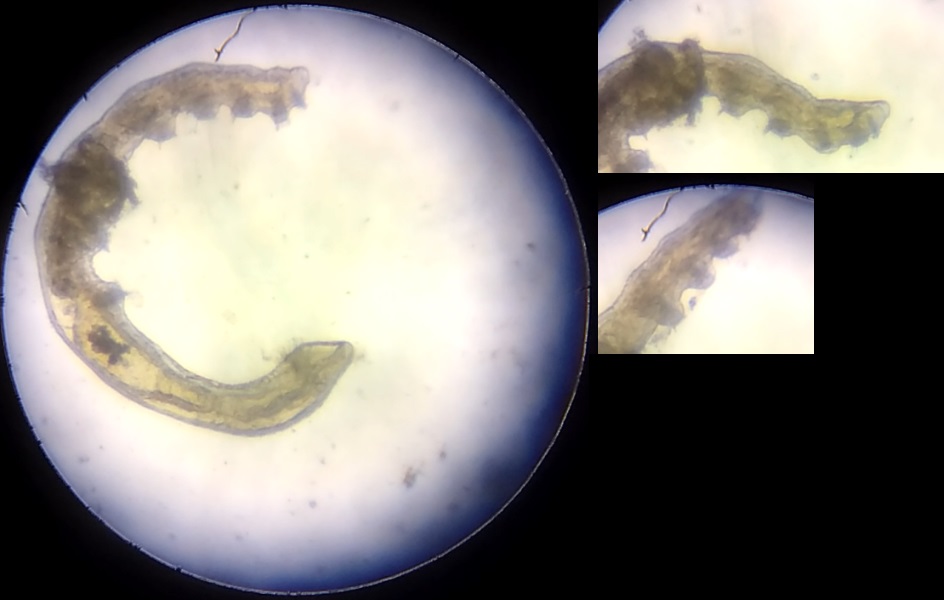I collected some bladder snails several months ago. While checking them out one day, I noticed that they were now infested with worm-like ectoparasites.
Appearance and behavior
Here's a picture of a snail with a bunch of the worms hanging off of it's head, where they tend to congregate. I've also circled one of the worms crawling along the glass.
I sampled some of the worms and took a look at them under a microscope. Here's a video ("Video 1" below) I recorded of one of them crawling around. They have some notable characteristics.
First, they appear to have some sort of sucker mouth.
Second, they have some interesting "legs" tipped with hairs (?) at the ends of their tails. Here's a short video ("Video 2" below) of a worm writhing around that shows them off a little better than pictures do. They appear to be in pairs of two.
Animated clips from the linked videos:
Video 1 (left) and Video 2 (right)
The length of the worms ranges from 1-5 mm (edit: they get larger; see below).
Update: After keeping infected snails for a while longer, I believe that these worms only parasitize bladder snails when the worms are young (within the aforementioned size range). Larger, adult worms appear to be free-living and growing up to 1-1.5cm, and will actually crawl away when snails disturb them. Here is a picture of an adult specimen (along with some smaller ones), no microscope required:
Here's a much better picture of the hair-like legs, of which this adult specimen has numerous pairs:
Lastly, here's a very interesting detail: These worms are highly specialized, and do not seem to affect ramshorn or pond snails, which I have numerous of in the same tank, in the slightest. It's only the bladder snails that end up infested.
Location
These snails were gathered in Canada, in a still-water area connected to the Oldman River. The river is accessible by cows and deer.
Reproduction
I have witnessed the snails shedding tons of cercariae into the water, which eventually disappear after a couple of hours (reinfect the snails?). I'm not sure if those are related to this worm, or if the snails are also infected with some other type of fluke.
Update: I now believe the aforementioned cercariae are unrelated to the worm in question. I managed to record an adult worm releasing numerous live young, which resemble tadpoles (trochophores?):
I've recorded a video of the worm giving birth that can be viewed here (left image below). The young seem to be stored in chambers inside of the parent, and then are pumped through the body and out the back end. While the young appear to be still in the video, some of them are quite active (right image below).
My theory at this point is that the young penetrate snails, grow inside of them, emerge and hang onto the host for a while, and then eventually dismount as free-living adults. Adult worms seem to be independent, while smaller worms hang off of the host the snail (feeding off of it?) until they're large enough to live freely.
Treatment
I would like to eliminate these worms if possible (I can't gather more snails any time soon, and they eventually kill off smaller snails). My first attempt was dosing with praziquantel, which is supposedly effective against flukes while being snail-friendly. Unfortunately, three days later, one of the snails died, and the worms appear to be unharmed.
Update: I gathered some more snails, and attempted praziquantel once again. While it did not harm the snails, it also continued to be ineffective against the worms. I have been experimenting with Seachem ParaGuard, and the results seem to be positive for minor infestations, but not against fully mature worms.
Conclusion
After some research, my best guess is that they're trematodes from the class Digenea-- They appear have sucker mouths, can parasitize snails exclusively, can have a free-swimming form, and can shed cercariae. That said, I'm not terribly confident, and would ideally like to be able to identify them more specifically.











